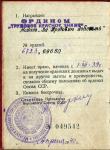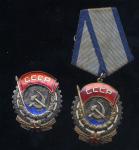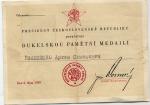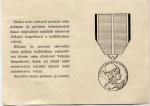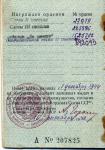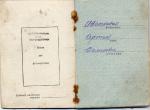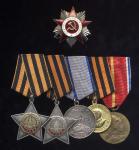-
Posts
14,343 -
Joined
-
Last visited
-
Days Won
25
Content Type
Profiles
Forums
Blogs
Gallery
Events
Store
Everything posted by Ed_Haynes
-

Soviet Ivan Pietrovitch Poletaev
Ed_Haynes replied to Ed_Haynes's topic in Russia: Soviet Orders, Medals & Decorations
-

Soviet Ivan Pietrovitch Poletaev
Ed_Haynes replied to Ed_Haynes's topic in Russia: Soviet Orders, Medals & Decorations
-

Soviet Ivan Pietrovitch Poletaev
Ed_Haynes replied to Ed_Haynes's topic in Russia: Soviet Orders, Medals & Decorations
-

Soviet Ivan Pietrovitch Poletaev
Ed_Haynes posted a topic in Russia: Soviet Orders, Medals & Decorations
-
And, believe it or not, Gerd, the scan doesn't really do it justice.
-
BIKANER:Order of the Sadul Star of Bikaner, 1st class Clearly the sash badge of "someone". Yellow and white gold set with diamonds and rubies.
-
And, therefore, it isn't "communist"? Can someone with The Power move it, please? We have actually gotten some lovely post-Imperial and pre-Revolutionary Chinese items over on the OMSAS site,and more to come. Now we just need some information!
-

Mongolia Honorary Medal of Combat
Ed_Haynes replied to Ed_Haynes's topic in People's Republic Mongolia
A pretty one, with some history on the ribbon! -

Soviet restoration of medals
Ed_Haynes replied to bifter's topic in Russia: Soviet Orders, Medals & Decorations
To clarify - Not all collectors of British medals like the plated and shiny ribbon look, no more than all US medal collectors like the anodized look that has been invented by some dealers. Yes, reribboning is more accepted than among, say, German collectors, but whose standards constitute the 'norm'? -

Soviet restoration of medals
Ed_Haynes replied to bifter's topic in Russia: Soviet Orders, Medals & Decorations
As I shall soon share here, I have an ethical dilemma brewing. Just picked up, yesterday, two nice WWII-era Soviet medals here in New Delhi (how'd they get here?): A four-digit "No." Medal for Bravery and a 1944-ish Medal for 'Combat' Service. They came with all suspension rings, but no suspenders and no ribbons. I am inclined to leave them loose. But . . . ??? -

Soviet restoration of medals
Ed_Haynes replied to bifter's topic in Russia: Soviet Orders, Medals & Decorations
Given conditions of climate and the systems of primary medal 'wholesaling' that prevail, it is rare that I see even a post-independence (post-1947) Indian group with original ribbons. Even groups come tied together with string or wire. So, unless one likes their medals naked, reribboning is an unfortunate fact of life. Sometimes reribboning is necessary to preserve the scraps of original ribbon that survive, but they are preserved. While old ribbon can be found, it is getting rarer than the medals themselves. Among collectors of British medals, reribboning has perhaps become too common, especially given the incredibly ugly modern ribbons that exist. Yet, I'd suggest that there are VAST differences among: 1- Reribboning naked medals. 2- Stripping off old ribbons and replacing with new glow-in-the-dark synthetics just becausde you like the tacky look. 3- Polishing medals and stripping away decades of sexy patina. 4- Dipping the medals in shiny plating stuff because you like sparkly things. 5- Enameling your medals pink, engraving your name on them, and drilling holes in them simply because you feel they are yours to do with as you wish. While we may differ on where the "good practices / naughty practices" line falls, we (or maybe at least most of us?) may agree that some of these are beyond the limits of ethical behavior. Tens of thousands of years ago, when I worked as a summer intern at the Smithsonian, two basic rules of preservation were stressed over and over: (1) Do no restoration that is not an obvious restoration, that can ever be confused with the original. If George Washington's uniform jacket needs reinforcing, do it where it cannot be seen with modern white chemically neutral thread and make no effort to use "replica" "period" thread. Do not try to fake originality. (2) Do no restoration that cannot be easily reversed without doing additional damage and above all make no permanent changes. If the enamel on General Pershing's Legion of Honor is cracked to the point that it REQUIRES fixing, do not under any circumstances re-enamel it, but use a white water-soluble material (I think it was something like a cornstarch and water paste with water colors mixed in) to reinforce it (that can easily be washed off later on). Aren't these fair guidelines for us? -

Named WWI Military Cross
Ed_Haynes replied to James T's topic in Great Britain: Orders, Gallantry, Campaign Medals
He is, by the way, not listed in the CWGC casualty rolls, so the chances are high that he suvived the war. Next stop? 1- His MIC medal card, available online at National Archives (for a fee) 2- War Diaries, at the National Archives 3- Regimental histories And, also, a good close look at the naming by someone familiar with his regiment. -

Named WWI Military Cross
Ed_Haynes replied to James T's topic in Great Britain: Orders, Gallantry, Campaign Medals
London Gazette, 31 January 1919 (published 1 February 1919), p. 1655 http://www.gazettes-online.co.uk/archiveVi...;selHonourType= "2nd Lt. Herbert Robert Davis, 2nd Bn., Lond.R. "For conspicuous gallantry and good leadership near Oisy-le-Verger on 27th September, 1918. He cleared over 2,000 yards of trench, system, including 18 dug-outs, a large wood and a cemetery. He skilfully outflanked machine guns and snipers, in one case having to make four distinct attacks before capturing an obstinate machine-gun post. His two platoons captured in all 100 prisoners, eight heavy and four light machine guns, and two anti-tank rifles." -

Named WWI Military Cross
Ed_Haynes replied to James T's topic in Great Britain: Orders, Gallantry, Campaign Medals
Let me see what I can find. The online London Gazette is notoriously cranky. And additional problem comes when some researchers/collectors record the actual date of the gazette (which you can find easily) and some record only the date of the notification (which you can't find). The best source for a full recommendation will be the war diary of his unit, and these are held in the National Archives at Kew, just outside London. Named MCs can be tricky for, as you said, all that are named have been done privately, and you can never be 100% sure when the naming was done, then or last week. -

Soviet restoration of medals
Ed_Haynes replied to bifter's topic in Russia: Soviet Orders, Medals & Decorations
Good points, all. But, Dick, how does one obtain eternal life? Like it or not, we are NOT the owners of these medals. The only 'owner' is the usually deceased recipient. It was his or her award, and he or she had certain rights. These included the right to reribbon, to modify (for example, screwback to pinback), to use fine enamel or nasty nail polish to repair enamel problems, or to carve their name on the reverse. All these rights lapsed with the death of the only real owner. Thereafter, we have become merely one in a string of custodians (unless Dick's eternal life magic is made public) who have rented (often with a hefty pricetag) the right to host this award for a few years or decades. Whether we see the medal as a short-term investment or a lifetime friend, we have only one right: to recognise that we do not have the right to make permanent changes to the medal and have the solemn duty to research the recipient to whatever extent we can so as to preserve their memory. Then, in a few decades, we pass the medal on to the next custodian in a chain that, we hope, stretches on into the future unless some intervening busy-body vandal mutilates the piece of history that once lay in our hands in and our collection. Sorry, guys, this is something I feel strongly about. I see this 'hobby' as being 'about' history and a debt to the past and not about crass personal property or easy greedy profits. These are not 'things' or 'private possessions', these are the only tangible pieces surviving of a person's life and history. -

Soviet restoration of medals
Ed_Haynes replied to bifter's topic in Russia: Soviet Orders, Medals & Decorations
It is always a tragedy to see an award with history, something someone may have given their life to deserve, turned into sewage. These aren't our possessions to do with as we wish, I fear. This has nothing to do with the "market value". but with issues far more important. So sad. -

Rare Egypt bar
Ed_Haynes replied to Chris Boonzaier's topic in Great Britain: Orders, Gallantry, Campaign Medals
My impression (= never seen this in the sources) is that the 1882 Egypt awards to Egyptains were named in the UK (as Egypt was after all in rebellion against the British and their collaborating 'friends' had their gongs UK-named), while later (e.g., Sudan) medals were named in country (and usually in a language relevant to the soldiers, as these awards were merely in addition to their own country's awards). I could be wrong, and would be happy to be proved wrong, but from sources not guessing. I have asked friends to have their students seek in the revelant archives (Cairo) and so far zero. Owain????? A medal that was rarely named (e.g. MC or 1939-45 Star [with exceptions]) found unnamed is no surprise to anyone, while one supposed to be named (e.g. Egypt 1882) that isn't tends to become a curiosity, absent evidence. Sad but true (unless someone seeks it to fill a 'gap'). -

Rare Egypt bar
Ed_Haynes replied to Chris Boonzaier's topic in Great Britain: Orders, Gallantry, Campaign Medals
Why this is unnamed is a puzzle. Away from my notes, I think this medal (unlike the Queen's Sdan or any of the later Egyptian medals) was named in English with merely a regimental number when given to Egyptian 'allied' troops. (BB&M is far from reliable on such details of non-European naming.) I'd suspect a mint escapee or later replacement which no one wanted to bother to pay to get named. (The authorities became, over the decades, quite cranky about replacement medals.) Value? Hard to say. Unnamed medals are not much more than a curiosity, holding no research interest. Surely less than one named to a native (of the British Isles), to an Indian, or to an Egyptian. Unless, of course, someone wanted one unnamed, to "splice" into a group missing one, for example (and then to invent a tall tale to cover the presence of a rogue unnamed medal). -
The other thread, by the way, is: http://gmic.co.uk/index.php?showtopic=2336 For those signed up over there, there is a longer discussion at http://sagongs.ipbhost.com/index.php?showtopic=181 There was a set of the later Souval restrikes just sold by Morton & Eden in the final part of their ANS sale. Went at a ridiculously high price for restrikes.



